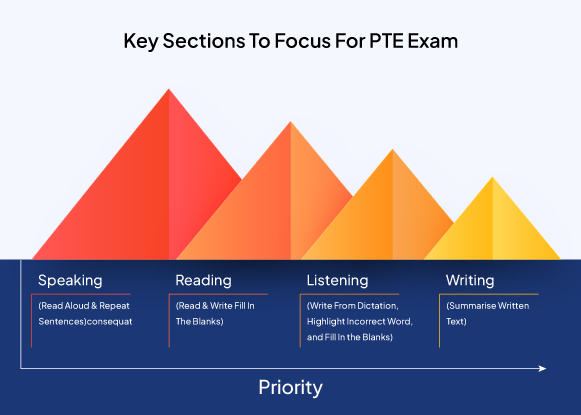Ever dreamt of studying in Australia, Canada, the USA, the UK, New Zealand, Singapore, Germany, Ireland, and the Netherlands? If yes, then scoring well in the PTE Exam & how to do PTE Exam Practice Online will always be the first question in your head. Before preparing you also should know about challenging sections in PTE.
The Pearson Test of English (PTE) is a critical gateway for students pursuing academic dreams in English-speaking countries. It is the exam that puts your English to the ultimate test – can you read complex texts, write clear arguments, listen to lectures, and chat like a champ. What is the PTE? It is the PTE exam developed by Pearson, featuring a computer-based format and a scoring system based on the Global Scale of English.
Knowing about the format of the PTE exam is not enough. The format can be confusing, and let’s face it! Online preparation can make the pressure of getting a good score even worse. The PTE Academic test has a comprehensive syllabus that assesses essential English skills such as Speaking, Writing, Reading, and Listening. It is very essential to address this confusion effectively to score high.
So here we are! Revealing most challenging PTE section and giving you accurate practice strategies for “How To Prepare For PTE”. By tackling these areas head-on, you’ll transform PTE test day into a victory march toward your academic dreams.
Understanding the PTE Exam
The PTE exam is a computer-based English language proficiency test designed to assess the speaking, writing, reading, and listening skills of non-native English speakers. This comprehensive test is divided into three main sections: Speaking and Writing, Reading, and Listening. Recognized by universities and institutions worldwide, the PTE exam evaluates the English language proficiency of international students, making it a crucial step for those aiming to study abroad.
Scored on a scale of 10 to 90, the PTE exam measures your ability to communicate effectively in English in a global setting. The results reflect your capability to convey ideas, deliver presentations, and perform confidently in front of foreign audiences. Whether you’re aiming for academic success or professional advancement, excelling in the PTE exam can open doors to numerous opportunities.
Exam Pattern & Sections In PTE
Understanding the PTE exam pattern is essential for effective preparation. The test is meticulously designed to assess the speaking, writing, reading, and listening skills of non-native English speakers. Sections in PTE are divided into: Speaking and Writing, Reading, and Listening.
The Speaking and Writing section evaluates your ability to communicate in English through various tasks. You’ll encounter question types such as Read Aloud, Repeat Sentence, Describe Image, Re-tell Lecture, Answer Short Question, Summarize Written Text, and Essay. This section tests both your verbal and written communication skills, making it a critical part of the exam.
The Reading section assesses your ability to comprehend written English. It includes question types like Multiple Choice, Multiple Answer, Re-order Paragraphs, Fill in the Blanks, and Highlight Correct Summary. This section requires you to demonstrate your reading comprehension and analytical skills.
The Listening section tests your ability to understand spoken English. You’ll face question types such as Multiple Choice, Single Answer, Multiple Choice, Multiple Answer, Fill in the Blanks, and Highlight Incorrect Words. This section challenges your listening comprehension and attention to detail.
Speaking Section
PTE Speaking section got you feeling speechless? Well, the first thing you can do is – Imagine talking to a friendly robot. Among all the sections of the PTE exam, Speaking can be considered challenging. This section evaluates two things- One side is your English skills (vocabulary, grammar), and the other side is your test-taking smartness (knowing what to focus on and managing time).
The Speaking Section in PTE features diverse tasks that put your English communication skills to the test, including pronunciation and vocabulary. Out of those question types, Read Aloud & Repeat Sentences are the most challenging and carry high weightage in the scoring.
In this PTE Section non-English speakers make major mistakes because of inappropriate pronunciation or words unfamiliar with the language. This reduces the scoring. It is advised to prioritise this section while preparing for the Pearson Test of English.
Here are bonus tips that will help you score your desired target for all sections in PTE
- Keep checking your pronunciation and practice well for it.
- Speak clearly and avoid pauses while answering.
- Repeat all the words in the same order without rushing.
- Practice phonetics & focus on word stress & sentence stress.
- Engage in regular speaking practice.
- Seek guidance from experts and start giving PTE Mock Tests
Reading Section
PTE Reading Section sometimes acts as a make-or-break zone for test takers. The reading section checks how well you understand what you read. The PTE exam pattern 2024 details the structure and timing of the test, outlining the specific sections and types of questions involved in assessing various English language skills necessary for studying internationally. It’s like a test to see if you can get the meaning of different kinds of writing. It includes R & W: Fill in the blanks, MCQ Multiple Single Answers, Re-Order Paragraphs, R (read): Fill In The Blanks & MCQ Single Answers question type.
Out of these question types of sections in PTE , the most important question type that has major weightage is “Read and write fill in the blanks.” Experts recommend prioritizing this section due to its time demands. Aim for 2-3 minutes per question during practice to develop efficient answering strategies.
To perform well in this section, here are some tips that you must follow to succeed.
- Skim and scan to save time! Skimming helps grasp the main ideas, and scanning helps find specific information.
- Understand question type, as it will help you in approaching strategically for a correct answer.
- Context is king! Pay attention to the surrounding words to identify the missing part of speech.
- There is no negative marking, so answer all the questions even if you are not sure.
- Make use of the rule of elimination. Narrow down your options as much as possible.

Listening Section
The PTE listening section can be a hurdle for many test-takers. The PTE test, known for its comprehensive evaluation of English language proficiency, has a scoring system that requires active listening to achieve high scores. Our fast-paced world, filled with constant notifications and distractions, develops the habit of “passive listening,” which might decrease one’s scores in the PTE Exam.
The PTE listening section is like a test of how well you understand English in everyday situations! You’ll hear conversations and lectures and then answer questions in different formats. This section comprises many question types.
Prioritising preparations means focusing more on Write From Dictation, Highlight Incorrect Word, and Fill In the Blanks.
Prepare well for this section, as your writing skills will also be tested. Strategic studying is key! By prioritising sections that need more work, you’ll maximise your score potential.
To level up your Listening Section preparation, here are some tips:
- Restrict your answer to 50-70 words & use the provided notepad to write down the keywords.
- It is recommended that you read the questions before the audio starts.
- Carefully listen and check whether the word was singular or plural, with an article or not, etc.
- Review your answers before submitting them in case you have missed something.
- Listen to new content as it will enhance your vocabulary and it will improve your understanding of spoken English.
- Stay focused till the end, as the answers could be in the end.
Writing Section
This section tests your ability to write in English effectively. The PTE Academic test is a comprehensive evaluation of candidates’ proficiency in English across essential skills such as Speaking, Writing, Reading, and Listening. While you’ll be using your speaking, reading, and listening skills throughout the exam, the writing tasks come after you finish speaking. To score well in this section, you need to have strong language skills, critical thinking, and time management.
Out of various question types , Summarise Written Text needs to be prioritised.
Since the PTE Writing section also relies on your reading comprehension, mastering reading strategies will give you a head start on these writing tasks.
Here are some tricks you can apply while preparing to enhance your preparations of sections in PTE:
- Give the passage a close read to find the main idea and key points. This will help you remember the most important information.
- Highlight or underline essential keywords that best determine the content. Use these keywords in your summary.
- Be concise and to the point. Focus on the facts.
- Use your own words by thinking of synonyms and paraphrasing. Use the third person. Avoid using “I,” “Me,” or “We”.
- Monitor the time during the exam. Allocate sufficient time for each part.
By tackling the most challenging sections head-on, you’ll be well-equipped to ace the exam. We’ve identified these sections and provided targeted practice strategies. Now, it’s your turn to put them into action! Remember, with focused practice and the right approach, you can conquer even the toughest parts of the PTE.
Preparing for the PTE Exam: Tips and Strategies
Preparing for the PTE exam requires a strategic approach and a solid understanding of the test format, question types, and scoring system. Here are some tips and strategies to help you excel in the section in PTE :
- Understand the test format: Familiarize yourself with the test format, question types, and scoring system. Knowing what to expect will help you manage your time and approach each section with confidence.
- Practice speaking and writing: Regularly practice speaking and writing in English to improve your communication skills. Engage in conversations, write essays, and seek feedback to enhance your proficiency.
- Improve your reading skills: Read extensively and practice reading comprehension. Focus on understanding the main ideas, details, and inferences in various texts.
- Enhance your listening skills: Listen to podcasts, audiobooks, and English language TV shows to improve your listening comprehension. Pay attention to different accents and speech patterns.
- Use online resources: Utilize online resources such as practice tests, study guides, and language learning apps to prepare for the test. These tools can provide valuable practice and insights.
- Join a study group: Join a study group or find a study partner to practice speaking and listening with. Collaborative learning can help you stay motivated and gain different perspectives.
- Get feedback: Seek feedback from a teacher or tutor to improve your speaking and writing skills. Constructive criticism can help you identify areas for improvement and refine your abilities.
Pro Tip – You can also use our PTE Score Calculator for compering your PTE score with IELTS Score.
By following these tips and strategies, you can enhance your preparation and increase your chances of scoring well on the PTE exam. Remember, consistent practice and a focused approach are key to achieving your desired score.
Conclusion:
Effective preparation goes beyond understanding the exam format. It requires a strategic focus on the most challenging areas, such as Read Aloud and Repeat Sentences in the Speaking section, Read and Write Fill in the Blanks in the Reading section and Writing from Dictation in the Listening section.
Put these practical tips into action for sections in PTE – pronunciation practice, phonetics drills, skimming & scanning texts, and active listening. This will enhance your performance in every section.
Also Read:







